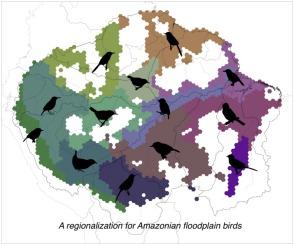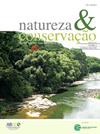亚马逊洪泛平原鸟类的特有性模式
IF 3.5
2区 环境科学与生态学
Q1 BIODIVERSITY CONSERVATION
引用次数: 0
摘要
主要根据鸟类物种的分布情况,将亚马孙地区划分为大面积的河流间特有地区(以主要河流为界),是了解和保护该生物群落巨型多样性的一个经常性出发点。然而,对于占据河流沿岸洪泛平原栖息地的 100 多种鸟类而言,它们的特有性区域或区域化区域尚未得到描述,因此预计其分布范围不会以河流本身为界。在这里,我们通过对更新的分布图(基于一个拥有 8 万多条出现记录的数据集)进行空间分析,针对修订后的 182 种洪泛平原特化鸟类分类群清单,确定了 10 个特有性区域和一个生物群落特定栖息地区域化的补充性区域(13 个区域)。对于洪泛平原鸟类而言,亚马逊河的主要河流被划分为不同的特有区域,而不是由河流划定这些区域。已确立的大型河流间特有性区域适合于陆地物种,但无法解释与洪泛平原栖息地相关的类群。特有物种的自然史特征和分类学表明,生态和历史进程都促成了所发现的模式。这种新的区域划分与将亚马孙视为生态区马赛克的观点相一致,并为研究其生物多样性中洪泛平原部分的演变和保护提供了一种补充方案。本文章由计算机程序翻译,如有差异,请以英文原文为准。

Patterns of endemism in Amazonian floodplain birds
The subdivision of Amazonia in large interfluvial areas of endemism (delimited by major rivers), based mostly on bird species distributions, has been a recurrent starting point to the understanding and conservation of the biome’s megadiversity. Yet, no areas of endemism or regionalization have been described for the well over 100 bird species that occupy floodplain habitats along the rivers, and thus are not expected to have ranges delimited by the rivers themselves. Here, through spatial analyses of updated range maps (based on a dataset with more than 80 thousand occurrence records), for a revised list of 182 floodplain specialized bird taxa, we identified ten areas of endemism and a complementary habitat-specific regionalization of the biome (with 13 regions). For the floodplain birds, Amazonian major rivers are segmented into distinct areas of endemism rather than these areas being delimited by the rivers. The well-established large interfluvial areas of endemism are appropriate for terra firme species but fail to account for taxa associated with floodplain habitats. Natural history traits and taxonomy of endemic species suggest that both ecological and historical processes have contributed to the patterns found. This new regionalization is consistent with the view of Amazonia as a mosaic of ecoregions and offers a complementary scheme for studies on the evolution and conservation of the floodplain component of its biodiversity.
求助全文
通过发布文献求助,成功后即可免费获取论文全文。
去求助
来源期刊

Perspectives in Ecology and Conservation
Environmental Science-Nature and Landscape Conservation
CiteScore
7.80
自引率
4.30%
发文量
46
审稿时长
59 days
期刊介绍:
Perspectives in Ecology and Conservation (PECON) is a scientific journal devoted to improving theoretical and conceptual aspects of conservation science. It has the main purpose of communicating new research and advances to different actors of society, including researchers, conservationists, practitioners, and policymakers. Perspectives in Ecology and Conservation publishes original papers on biodiversity conservation and restoration, on the main drivers affecting native ecosystems, and on nature’s benefits to people and human wellbeing. This scope includes studies on biodiversity patterns, the effects of habitat loss, fragmentation, biological invasion and climate change on biodiversity, conservation genetics, spatial conservation planning, ecosystem management, ecosystem services, sustainability and resilience of socio-ecological systems, conservation policy, among others.
 求助内容:
求助内容: 应助结果提醒方式:
应助结果提醒方式:


